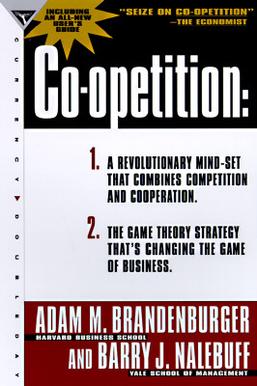Related Research Articles
In the field of management, strategic management involves the formulation and implementation of the major goals and initiatives taken by an organization's managers on behalf of stakeholders, based on consideration of resources and an assessment of the internal and external environments in which the organization operates. Strategic management provides overall direction to an enterprise and involves specifying the organization's objectives, developing policies and plans to achieve those objectives, and then allocating resources to implement the plans. Academics and practicing managers have developed numerous models and frameworks to assist in strategic decision-making in the context of complex environments and competitive dynamics. Strategic management is not static in nature; the models can include a feedback loop to monitor execution and to inform the next round of planning.
In business, a competitive advantage is an attribute that allows an organization to outperform its competitors.
A cross-functional team, also known as a multidisciplinary team or interdisciplinary team, is a group of people with different functional expertise working toward a common goal. It may include people from finance, marketing, operations, and human resources departments. Typically, it includes employees from all levels of an organization. Members may also come from outside an organization.

Cooperation is the process of groups of organisms working or acting together for common, mutual, or some underlying benefit, as opposed to working in competition for selfish benefit. Many animal and plant species cooperate both with other members of their own species and with members of other species.
A strategic alliance is an agreement between two or more parties to pursue a set of agreed upon objectives needed while remaining independent organizations.
A strategic partnership is a relationship between two commercial enterprises, usually formalized by one or more business contracts. A strategic partnership will usually fall short of a legal partnership entity, agency, or corporate affiliate relationship. Strategic partnerships can take on various forms from shake hand agreements, contractual cooperation's all the way to equity alliances, either the formation of a joint venture or cross-holdings in each other.
Cooperative learning is an educational approach which aims to organize classroom activities into academic and social learning experiences. There is much more to cooperative learning than merely arranging students into groups, and it has been described as "structuring positive interdependence." Students must work in groups to complete tasks collectively toward academic goals. Unlike individual learning, which can be competitive in nature, students learning cooperatively can capitalize on one another's resources and skills. Furthermore, the teacher's role changes from giving information to facilitating students' learning. Everyone succeeds when the group succeeds. Ross and Smyth (1995) describe successful cooperative learning tasks as intellectually demanding, creative, open-ended, and involve higher-order thinking tasks. Cooperative learning has also been linked to increased levels of student satisfaction.
Barry J. Nalebuff is an American businessman, business theorist, and writer. He is a Milton Steinbach Professor of Management at Yale School of Management and author who specializes in business strategy and game theory. His published books include Thinking Strategically and The Art of Strategy. Nalebuff's class on negotiation has over 67,000 active learners through Coursera and has the second-highest net promoter score on the platform. He has a semi-regular column in Forbes with Ian Ayres called "Why Not?"
A collective action problem or social dilemma is a situation in which all individuals would be better off cooperating but fail to do so because of conflicting interests between individuals that discourage joint action. The collective action problem has been addressed in political philosophy for centuries, but was most clearly established in 1965 in Mancur Olson's The Logic of Collective Action.
Innovation management is a combination of the management of innovation processes, and change management. It refers to product, business process, marketing and organizational innovation. Innovation management is the subject of ISO 56000 series standards being developed by ISO TC 279.
For international trade, Foreign market entry modes are the ways in which a company can expand its services into a non-domestic market.
Philippe N. Baumard graduated from the University of Aix-Marseille II, and Paris Dauphine University. Philippe Baumard is an organizational scientist who has held visiting professorships at New York University from 1997 to 1998, University of California, Berkeley from 2004 to 2007, Stanford University from 2008 to 2010. He is currently professor at the French National Conservatory of Arts and Crafts (CNAM), associate-researcher at École Polytechnique's Chair on Innovation & Regulation, Paris, and president of the scientific council of France's High Council for Strategic Education and Research
Vincent Mangematin is a French researcher and professor in management, specialized in Strategy, Strategic management of Innovation and Technology Management. He is currently professor and scientific director at Grenoble Ecole de Management.

This article outlines the evolution of management systems. A management system is the framework of processes and procedures used to ensure that an organization can fulfill all tasks required to achieve its objectives.

In R&D management and systems development, open coopetition or open-coopetition is a neologism to describe cooperation among competitors in the open-source arena. The term was first coined by the scholars Jose Teixeira and Tingting Lin to describe how rival firms that, while competing with similar products in the same markets, cooperate which each other in the development of open-source projects in the co-development of Webkit).

Co-opetition: A Revolution Mindset that Combines Competition and Cooperation is a non-fiction book on coopetition, business strategy, and game theory by Adam M. Brandenburger and Barry J. Nalebuff. The book was initially published by Crown Business on May 1, 1996. As of 2015, the book is still available in its 9th printing.

Thinking Strategically: The Competitive Edge in Business, Politics, and Everyday Life is a non-fiction book by Indian-American economist Avinash Dixit and Barry Nalebuff, a professor of economics and management at Yale School of Management. The text was initially published by W. W. Norton & Company on February 1, 1991.
Co-opetition or coopetition – simultaneous competition and cooperation – is an important philosophy or strategy that goes beyond the conventional rules of competition and cooperation to achieve advantages of both. Global co-opetition, an application of co-opetition in a global context, is first systematically addressed in Luo’s (2004) book “Coopetition in international business”. According to this book, global co-opetition refers to the simultaneous competition and cooperation between multinational enterprises (MNEs) and their geographically dispersed business stakeholders such as global rivals, global suppliers, global distributors, global alliance partners, and foreign governments as well as among foreign subsidiaries within an MNE.

Yadong Luo is the Emery M. Findley distinguished chair and professor of management at the University of Miami in Coral Gables, Florida.
Giovanni Battista Dagnino is an Italian economist and academic. He is the Chair of Management and Professor of Digital Strategy at the Libera Università Maria SS. Assunta University of Rome, where he is the Founding Director of the MSc Degree in Economics and Management.
References
- 1 2 Paul Terry Cherington, Advertising as a Business Force: A Compilation of Experience Records, Doubleday, for the Associated advertising clubs of America, 1913, p. 144.
- ↑ Dagnino, Giovanni Battista; Padula, Giovanna (2002-05-08). "Coopetition Strategy: Towards a New Kind of Interfirm Dynamics for Value Creation" (PDF). EURAM 2nd Annual Conference, Stockholm School of Entrepreneurship, Sweden.
- 1 2 Asgari, Sadegh; Afshar, Abbas; Madani, Kaveh (2014). "Cooperative Game Theoretic Framework for Joint Resource Management in Construction". Journal of Construction Engineering and Management. 140 (3): 04013066. doi:10.1061/(asce)co.1943-7862.0000818. 04013066.
- ↑ Mariani, Marcello (2007). "Coopetition as an Emergent Strategy: Empirical Evidence from an Italian Consortium of Opera Houses". International Studies of Management & Organization. 37 (2): 97–126. doi:10.2753/IMO0020-8825370205. S2CID 154396608.
- ↑ Loebecke, C.; Van Fenema, P.; Powell, P. (1999). "Coopetition and Knowledge Transfer". ACM SIGMIS Database. 30 (2): 14–25. doi: 10.1145/383371.383373 . S2CID 5707491.
- ↑ Ghobadi, Shahla (2012). "Knowledge sharing in cross‐functional teams: a coopetitive model". Journal of Knowledge Management. 16 (2): 285–301. doi:10.1108/13673271211218889.
- ↑ Ghobadi, Shahla; D'Ambra, John. "Coopetitive knowledge sharing: An analytical review of literature". The Electronic Journal of Knowledge Management. 9 (4): 307–317. Archived from the original on 2016-03-04. Retrieved 2015-06-18.
- ↑ "Co-opetition", Los Angeles Times, 1937-11-20, p. a4
- ↑ "Superpublius".
- ↑ Fisher, Lawrence M. (1992-03-29). "Preaching Love Thy Competitor". The New York Times . Archived from the original on 2018-06-27. Retrieved 2018-08-04.
- ↑ Williamson, Marcus (2006-10-09). "Obituary - Ray Noorda - Pioneer of 'co-opetition'". The Independent (UK) . Archived from the original on 2018-08-04. Retrieved 2018-08-04.
- ↑ "Phoenix Fire Inc".
- ↑ Kamen, Dean (2009-03-24). "US Patent 7,507,169". US Patent Office.
- ↑ "FIRST values" Archived 2010-01-29 at the Wayback Machine
- ↑ Waltrip, Darrell. "For Gordon and Johnson, "coopetition" is a winning strategy".
- ↑ Gnyawali, Devi R.; Park, Byung-Jin (Robert) (2011-06-01). "Co-opetition between giants: Collaboration with competitors for technological innovation - Drivers and Consequences of Collaboration between Large Competitors". Research Policy. 40 (5): 650–663. doi:10.1016/j.respol.2011.01.009.
- ↑ Gnyawali, Devi R.; Park, Byung-Jin (Robert) (2009-07-01). "Co-opetition and Technological Innovation in Small and Medium-Sized Enterprises: A Multi-Level Conceptual Model". Journal of Small Business Management. 47 (3): 308–330. doi:10.1111/j.1540-627X.2009.00273.x. ISSN 1540-627X. S2CID 53064594.
- ↑ Ghobadi, Shahla (2012). "Coopetitive relationships in cross-functional software development teams: How to model and measure?". Journal of Systems and Software. 85 (5): 1096–1104. doi:10.1016/j.jss.2011.12.027.
- ↑ Ghobadi, Shahla (2012). "Modeling High-Quality Knowledge Sharing in cross-functional development teams". Information Processing & Management. 49 (1): 138–157. doi:10.1016/j.ipm.2012.07.001.
- ↑ "Compassion Games International". Archived from the original on 2013-12-02. Retrieved 2014-01-15.
- ↑ "Love This Place, Serve the Earth: Collaboration is Necessary for the Earth 2016-04-18".
- ↑ Caring Citizens' Congress
- ↑ "Compassion Primaries Invite Coopetition - Empathy Surplus Project". Archived from the original on 2014-02-03. Retrieved 2014-02-01.